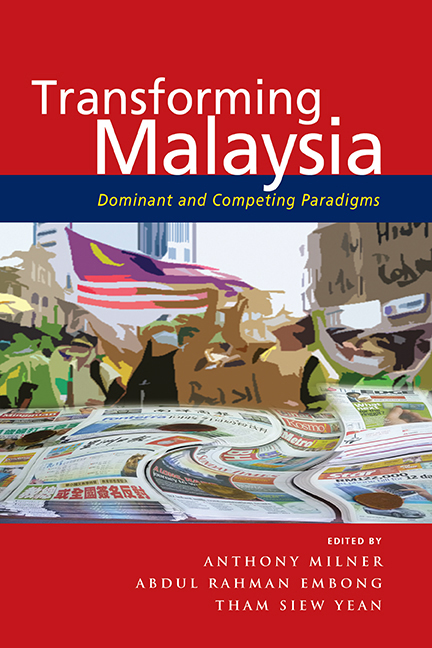Book contents
- Frontmatter
- Contents
- List of Tables and Figures
- Preface
- Acknowledgements
- List of Contributors
- 1 Introduction
- 2 Race and Its Competing Paradigms: A Historical Review
- 3 Knowledge Construction, the Rakyat Paradigm and Malaysia's Social Cohesion
- 4 Race Paradigm and Nation-Building in Malaysia
- 5 Race-Based Paradigm in Poverty Eradication and Income Distribution Analysis and Policy
- 6 Foreign Workers in Malaysia in the Post-Independence Era: Race Paradigm in State Policy, Academic Writings and Public Discourse
- 7 Trade Policy Formulation in Malaysia: Navigating between the Economic and Race Paradigms
- 8 National Security Conceptions and Foreign Policy Behaviour: Transcending the Dominant Race Paradigm?
- Index
1 - Introduction
Published online by Cambridge University Press: 21 October 2015
- Frontmatter
- Contents
- List of Tables and Figures
- Preface
- Acknowledgements
- List of Contributors
- 1 Introduction
- 2 Race and Its Competing Paradigms: A Historical Review
- 3 Knowledge Construction, the Rakyat Paradigm and Malaysia's Social Cohesion
- 4 Race Paradigm and Nation-Building in Malaysia
- 5 Race-Based Paradigm in Poverty Eradication and Income Distribution Analysis and Policy
- 6 Foreign Workers in Malaysia in the Post-Independence Era: Race Paradigm in State Policy, Academic Writings and Public Discourse
- 7 Trade Policy Formulation in Malaysia: Navigating between the Economic and Race Paradigms
- 8 National Security Conceptions and Foreign Policy Behaviour: Transcending the Dominant Race Paradigm?
- Index
Summary
An issue persistently focused on in public discussion in Malaysia today is the challenge of becoming a high-income country and a developed nation — and to do this by the year 2020. Time is running out, and yet influential Malaysians feel they have “become stuck” or “trapped” at a middle stage in the developmental trajectory. What is it that holds Malaysia back and prevents the country from achieving its promise? Attention is repeatedly drawn to the ethnic or racial structure of its population, and the policy demand on the government that arises because of the inequalities in this structure. Blame for Malaysia having become trapped is often attributed to the consequences of a demographic fact — to the country having a ‘plural society’ driven by racial or communal difference and contest, and a damaging structure of race-stirring politics generated by that society. But are we dealing here with givens? What of human agency — and, in particular, of the role of ideas and ideological skillfulness?
This book argues that the ideological aspect of the “Malaysia question” has been neglected, and that there is a need to examine closely the construction of what became established as the dominant societal paradigm of social and political life in the country. The authors consider first, the way the race paradigm — the rigid structure of “Malay”, “Chinese” and “Indian” — has been both constructed and contested; and secondly, the particular manner in which the paradigm continues to be employed in a range of practical, policy areas. Although the range of issues examined in the second half of the book is by no means comprehensive or exhaustive, nevertheless, they include significant areas in the policy discourse — namely poverty eradication and income distribution; foreign workers; trade policy formulation; and foreign policy. Each of the issues throws light on whether there are signs that the race paradigm is becoming less influential; and, also, what other ideological constructions are available — constructions which might be of greater strategic value to a country determined to achieve a new level of economic and political development? Seen in this way, each chapter provides some insight into the workings or impact of the race paradigm in official discourse and policy formulation as well as public and academic deliberations.
- Type
- Chapter
- Information
- Transforming MalaysiaDominant and Competing Paradigms, pp. 1 - 17Publisher: ISEAS–Yusof Ishak InstitutePrint publication year: 2014



